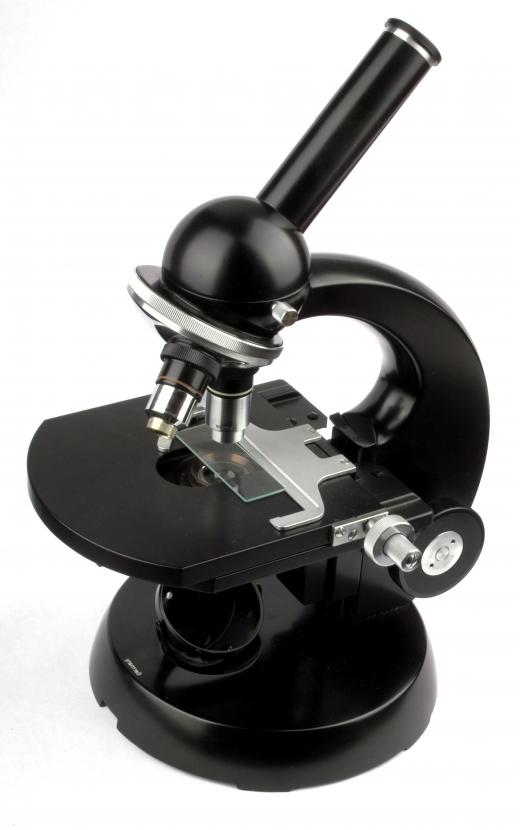What is a Microscope Stage?
 Mary McMahon
Mary McMahon
A microscope stage is the part of a microscope where a specimen is mounted for viewing. Classically, the specimen is placed on the stage on a slide, which can be clipped into place with the use of stage clips. There are a number of types of microscope stages designed for different microscopy applications, ranging from the basic stages found in high school laboratories to micromanipulators, which come complete with robotic arms which can be used for very precise, controlled manipulation of specimens on the stage.
Just like a theatrical stage, a microscope stage is used to showcase the star of the show. The stage is designed to be fully illuminated by the microscope's light, or to hold a specimen in place when other types of imaging technology are used. Using markings on the stage, observers can perform measurements and position specimens very precisely, and the position of the stage may be adjustable to get images from a different angle or to allow a researcher to see a whole slide without having to manually reposition it.

A basic microscope stage is fixed in place, requiring manual manipulation if the slide needs to be moved or adjusted. Mechanical stages are adjustable, while circular stages provide a greater range of motion and adjustability. Stages can also be equipped with micromanipulator arms and other useful microscopy tools.
Generally, the more elaborate the microscope stage, the more expensive it will be, and the better a microscope's quality, the better a stage it will have. Researchers who work with microscopes often need to be able to perform very fine and precise adjustments, and the ability to make such adjustments is a major advertising feature for sophisticated stage. Additional features like the ability to create a controlled environment for observing live specimens may also be important to microscope users.

Depending on the microscope, it may be possible to easily remove a stage for replacement, or it may be more challenging. Basic microscopes tend to come with limited options, forcing people to stick with the lenses, stages, and other parts which the microscope came with. More advantaged microscopes may be outfitted for versatility, with parts which can easily be exchanged with compatible replacements produced by the manufacturer or a subcontractor. It may also be periodically necessary to remove the microscope stage for servicing and cleaning to keep the microscope performing at its best, in which case a quick release can be very convenient.
AS FEATURED ON:
AS FEATURED ON:














Discussion Comments
@fify-- Actually, there are stages that heat up, but the microscope has to be a special one that has a heating chamber on it. When you put a specimen on a heat insulating stage and turn the heating chamber on, the stage heats up and so does the specimen. It's possible to go up to seven hundred degrees celsius with it but that's usually not necessary.
I believe these stages were produced to examine how something went from solid to fluid form and to determine melting points of substances. I don't know if there are any cooling stages or microscopes yet.
Interesting article. I didn't know that there were such advanced microscope stages available. I especially like that there are round ones that could be rotated in any direction to get the best view.
I wonder what else could be done with microscopic stages. What if there were ones that could be heated or cooled down? It might be helpful to see how a specimen would react to different temperatures. What do you think? Will they make microscopic stages like that?
Post your comments